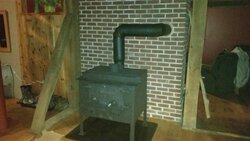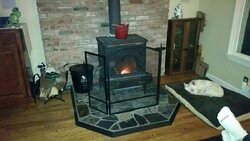
I bought this Fire Boss insert for $100 and made it into a wood stove. Wouldn't normally do something like that but it was cheap and the louvers were already cut out. So i figured I'd use it for the time being since my Van Wert boiler was out of commission....(another story for another day). I ran it all night and it was 80 in the house so it works...lol. But i noticed smoke in my kitchen and living room. And cant tell where its coming from. I thought originally it was from me having the door cracked during initial start up. But I opened the doors and windows and it was still a little hazy. Now I can handle this. But my pregnant asthmatic wife cannot. Is there any test I can do to find the leak. And is my stove piping alignment suitable? I'd like to make this work for at least this winter. To at least get my money out of it. Thanks from a first time home/woodstove owner


